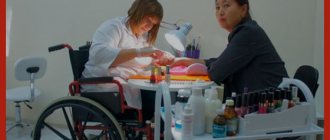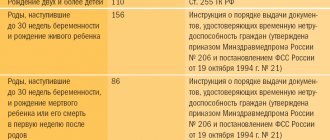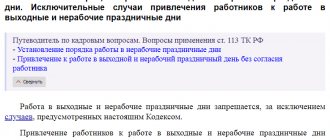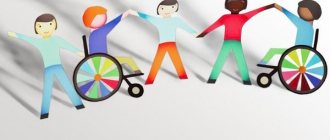Home page » Pensions for disabled people » Working and non-working disability groups in 2021
Which disability group is working in 2021? This question is quite difficult to answer, since there is no official division of groups into workers or non-workers. A person with any group can be declared incapacitated fully or partially (for certain types of work) only based on a medical report.
- First disability group
- 2nd group
- Third disability group
- Conclusion
Disability is a systematic impairment of a person's health, as a result of which he becomes incapacitated or loses the ability to perform any specific work.
It is believed that with group 1 a disabled person is not able to perform work duties, group II is partially non-working, and group III is working.
Can a disabled person work?
Specifically, Russian legislation does not prohibit disabled people from working. Moreover, people with the same disability group may fall into the category of those who can work and those who cannot work. You need to take into account many factors. And a person’s physical abilities are not the most important thing. Also taken into account:
- mental capabilities;
- a person’s ability to care for himself independently (without additional help or when certain conditions are created);
- mental condition;
- the opportunity to interact with society.
Often, restrictions for people with disability groups 2 and 3 do not relate to work activity in general, but relate to certain professions. For example, a blind person can perform work related to mental activity. There are also places where such citizens work with their hands (for example, making dishes from clay).
Period of disability
The first group is established for a duration of two years. For other groups this period is 12 months. If we talk about children recognized as disabled, then depending on the severity of the disease, a group can be assigned for 12 or 24 months or until they reach adulthood. The law reflects situations where the period is not limited:
- the presence of anatomical defects in a person;
- the violations are irreversible;
- rehabilitation of the person did not bring the desired result;
- there is no opportunity to undergo social adaptation;
- the dynamics of working capacity are assessed as unfavorable.
Restrictions are related to age category. For males this is 60 years old, for females – 55. Before the expiration of this period, re-examination must be completed due to changes in health. Errors made by experts may be identified. This situation applies to those for whom disability is established without a period limitation. If the procedure is not completed on time, the disabled status is lost.
You can undergo re-examination in advance. This is done no earlier than a couple of months before the expiration of the previous conclusion. Contact the SME Bureau.
Who determines whether a disabled person can work?
The determination of the disability group is carried out by specialists from the Bureau of Medical and Social Expertise (MSE). After a person has gone through all the doctors, his situation is examined in detail. Recognition of a specific disability group is possible if 2 of the 3 following factors are met:
- partial or complete loss of vital functions;
- complete or partial inability to care for oneself, to communicate with people (the person cannot communicate, is disoriented or cannot control himself);
- the need to receive medical care and rehabilitation measures.
Disability is not always assigned due to some kind of physical injury.
The reason for assigning one or another group can even be a mental illness that has led to a person’s inability to live independently and control himself. The decision on disability is made collectively. The result is the establishment of a specific group. An individual rehabilitation program (IRP) for a disabled person must also be drawn up. According to Art. 11 of Federal Law No. 181-FZ of November 24, 1995, it includes not only medical and rehabilitation measures, but also professional measures.
IPR is a program that is obligated not only by authorities and budgetary institutions, but also by organizations if they employ a person with a disability.
In the IPR, much attention is paid to the issue of professional support measures. So, if a person is partially able to work, then the program prescribes labor restrictions, as well as a list of professions for which the person is not eligible. Moreover, here they proceed more from the fact that a person does not harm his health or worsen his well-being.
Link to document: “On social protection of disabled people in the Russian Federation”
Disability depending on the degree of disease
The corresponding document describes in detail the procedure for registering and re-registering groups, and clarifies the composition of the basic set of privileges for people with disabilities.
In order for MSEC to confirm a disability, certain conditions must be present:
- A persistent disorder of key life functions, provoked by an acquired pathology and its severe consequences, trauma, etc.
- Narrowing of the ability for full self-care, communication with other people, orientation in the environment, self-control.
- The need for medical correction and rehabilitation, social support.
Only one of the mentioned points is not enough to form a group - at least two are required. All features of each specific case are carefully checked by competent members of the commission, acting in accordance with the requirements of the law.
There are working and non-working disability groups; this year the criteria for determining them were revised. Disabled people, according to the law, receive full rights to pension payments and a package of social benefits. What the amount of the pension will be depends on the disability group; in Russia it is expected to increase by the end of this year.
If the law requires two types of pension at once, then the applicant must choose only one of them. At the same time, the monthly financial payment does not stop; a set of social services is provided, which, if necessary, can be replaced with monetary compensation. Insurance assistance is paid when a person has insurance coverage.
When considering questions about the advisability of assigning a disability group, the real cause of the resulting disability must be taken into account. It is allowed to indicate the following factors:
- general illness – indolent pathology or domestic trauma;
- injury received during the production process while a person was at the place of work, on the way to or from it;
- occupational illnesses that arose as a result of exposure to harmful production factors;
- injuries acquired during combat operations, during military service, as well as during the Patriotic War;
- genetic developmental abnormalities, complications of childhood illnesses;
- radiation exposure.
In order to prove the true cause of disability, the applicant is required to provide relevant documentation. In the absence of such, a note “general disease” is made. Sometimes it happens that disability is caused by more than one factor. In this situation, the disabled person himself or his official representative chooses the reason, which will serve as the reason for starting the examination.
Disability groups: when can you work?
The degree of the disease directly affects the person’s disability group.
She, in turn, determines whether such a patient can work or not. It is usually considered that groups 1 and 2 are partially or completely incapacitated, and 3 are fully able to work. But special cases are possible. The need to work for a person with a disability may be due to various reasons. Some people just need money, others want to realize their creative potential. Disabled people in group 2 receive more significant financial support than people in group 3. However, for the latter, more alternative formats of support in the labor sphere are provided. For example, a person with disability group 3 can receive assistance in finding employment from social protection.
The state cannot prohibit a person with any degree of disability from working. On the contrary, such people have the right to work. But they can’t get any position. If the IPR contains restrictions, the employer must follow them.
Establishment of permanent disability of the 3rd group in 2020
Based on the results of the review, MSEC extends or removes disability, and if the patient’s health status changes (deterioration or improvement), it can change the group. If the patient is on an old-age pension, permanent disability of group 3 may be indicated (according to the law of 2021)
Thus, to obtain a disability group there must be objective reasons. The applicant is obliged to provide the special commission with a complete package of documents (their list is provided above). The latter are official confirmation of the fact of disability, the need for financial assistance, and all possible protection from the state.
Assistance in finding employment for people with disabilities
The state not only does not prohibit people with disabilities from working, but also helps them find employment. Employment for people with disabilities is ensured through a number of measures prescribed in Art. 20 No. 181-FZ. This includes:
- quotas for jobs at certain enterprises;
- reserving places in a number of professions that are most suitable for such people;
- encouraging organizations to create jobs specifically for people with disabilities (tax and other preferences);
- organization of vocational training or retraining (if the employed person received a disability and he cannot continue to work in his previous position).
All these measures taken together allow people with disabilities to find a suitable place of work.
Quotas
If an organization employs 35 people or more (excluding positions with harmful or difficult working conditions, since such positions cannot be filled by people with disabilities), then the head of the enterprise must provide a quota - a certain number of places for people with disabilities. Their number is determined based on the average number of employees and depends on the volume of the enterprise:
- when the number of employees is from 35 to 100 people, 3% of quota places are provided for people with disabilities (1–3 people);
- with a workforce of more than 100 people, the enterprise must allocate places for disabled people within 2–4%.
The obligation to provide jobs for persons with disabilities does not apply to small enterprises (those with fewer than 35 employees) and certain forms of associations created by persons with disabilities themselves.
List of suitable professions
The legislation also establishes a list of priority professions for persons with disabilities. This list is given in Resolution of the Ministry of Labor of the Russian Federation No. 150 of September 8, 1993. The list is quite long. It mainly includes professions not related to physical labor. For example, this includes:
- artist;
- photographer;
- teacher;
- secretary;
- manicurist;
- dispatcher;
- accountant.
Moreover, the employer who accepts a disabled person into the team must remember that he has the responsibility to arrange a place for work in accordance with the requirements prescribed by law and in accordance with what is specified in the IPR. The equipment features are specified in the order of the Ministry of Labor of the Russian Federation No. 685n dated November 19, 2013. Moreover, they usually apply to persons with disability groups 1 or 2, since people with group 3 can often carry out activities without additional restrictions and special working conditions.
Link to document:
Link to document:
Documents for registration of disability groups 1, 2 and 3 in 2020
The definition of groups is within the competence of MSEC (its composition is formed in accordance with the law). The process is carried out in one of the following ways:
- After proper diagnosis and a course of therapy, the doctor himself advises the patient to register for a group and refers him to a special examination.
- The patient himself tells the attending physician about his desire to receive a group.
The doctor enters the necessary information into the patient’s medical record and signs the referral for medical examination. It should be recognized that sometimes people have to make great efforts to achieve group assignment, to actively prove that actual health problems actually impair their quality of life.
An indicative list of official documents that will be needed when registering disability groups 1, 2, 3 in 2021 looks something like this:
- Medical referral for medical examination.
- Passport and its photocopy.
- A notarized photocopy of the current work book.
- Outpatient card.
- Originals and photocopies of all epicrises, extracts from medical institutions where the person was treated.
- Patient's application for examination.
Sometimes it is necessary to provide a certificate of income, characteristics from the employer or from the place of study. It is advisable to take care of preparing documents explaining the reason for the disability, because the amount of privileges and payments may depend on this.
If the expert commission has established a disability, the person is given a certificate of incapacity for work, as well as a personal scheme of measures related to rehabilitation. With these documents, the disabled person is sent to the social security organization and pension fund.
You also need to undergo a so-called re-examination - once or twice every two years. For this procedure, you should collect the same set of documents as for the initial examination, and also bring a certificate of current disability and a rehabilitation plan.
Labor benefits for disabled people
Disabled people receive a wide range of preferences from the state.
The latter, in turn, tries to help people with disabilities. In addition to material support in the form of pensions and daily allowance, social forms of assistance are also provided. For example, discounts on utility bills, free or partially free medical care. For those disabled people who decide to continue working, labor benefits are no less important. Their legislation has established a lot. Here's what the most significant ones look like:
- Shortened working week for disabled people of groups 1 and 2 . Its duration is 35 hours. At the same time, a disabled person has the right, at his own request and in agreement with the manager, to work longer. The latter must understand that for a shortened week he is obliged to pay a salary of 100%, and additional hours will already be overtime and must be paid for as overtime.
- No need to work at night, on weekends or holidays . However, if a disabled person himself has expressed a desire to go to work at this time, then the employer must obtain written consent from him.
- Providing additional leave. Its duration can reach 2 months, but the employer does not pay for them.
Obtaining all these preferences is possible subject to official employment. If a person works without a labor record, he does not receive any guarantees. They also do not apply when a disabled person decides to conduct business. But in this case he has more freedom, he has the right to manage his time and organize his work. But in business, no one guarantees a minimum salary. You can earn a lot or burn out and go into the red.
Read: Additional payment to pensions for disabled people of group 2 in 2021
What you need to know
All three disability groups differ in a number of characteristics.
It is they who determine which of them give the right to work, and subject to what restrictions. The legislation establishes that in order to be assigned the required disability group, a citizen must undergo a medical and social examination (MSE).
During the examination, not only the state of health, but also the person’s psyche will be checked (Article 1 of Federal Law No. 181).
People are distributed into groups according to the list of diseases and the degree of their severity approved in the RF Regulation No. The examination is carried out collectively, the decision of the ITU is also made collectively.
Important! A person can also be prohibited from working during the period of rehabilitation, when in order to restore health it is necessary to abstain from work. The illness or injury itself may result from:
- accident;
- development of occupational diseases;
- genetic abnormalities;
- getting injured;
- serving in the army;
- liquidation of the consequences of a disaster, radiation, etc.
Download for viewing and printing:
Federal Law of November 24, 1995 No. 181-FZ “On Social Protection of Disabled Persons in the Russian Federation”
Decree of the Government of the Russian Federation of February 20, 2006 No. 95 “On the procedure and conditions for recognizing a person as disabled”
Vital parameters
Since 2021, the criteria for determining the disability group have changed.
Now experts will spend more time on the severity of disorders of body function and the consequences that occur as a result of illnesses and injuries. Previously, the concept of “disability” was in force, which meant that a person, due to injuries received (classified as a certain disability group), could not freely work, study, or even serve his own needs.
In 2015, the term “habilitation” was introduced, denoting the ability of a disabled person to adapt to the everyday, social and work sphere with his existing injuries and diseases. In fact, the disabled person had to re-learn, work and go out on his own. In turn, the state had to provide them with accessible means of transportation to any cultural events and other objects.
Degrees of dysfunction of the human body
Signs and consequences of diseases are presented in the table below.
| Disability group | Observed violations |
| First | Significant restrictions that allow you to take care of yourself and limit the work functions of a disabled person |
| Second | Serious defects that partially limit the possibility of self-care and, much more, ability to work |
| Third | Persistent defects that limit some functions, but allow you to engage in work without serious physical activity. People with group 3 are able to take care of themselves without outside help. |
On a note!
There is also a conditional group 4, which includes persons whose illnesses are minor and do not qualify for disability. As a result, if there are some physical and/or mental disabilities, a citizen can fully or partially take care of himself and carry out certain types of work, but in other cases, work is contraindicated for him or is inaccessible due to illness.
Legal basis
The groups are differentiated according to the possibility of carrying out work activities:
- Group 1 is considered non-working;
- Groups 2 and 3 - workers.
But formally, the legislation allows people from any group to work (according to Article 3 of the Labor Code). The only question is the existing restrictions and remuneration. Persons with group 3 cannot be refused employment and receive a full salary only on the basis of disability.
When conducting an examination and making a diagnosis, doctors rely on the RF PP No., which regulates the procedure and conditions for assigning disability. The appendix to the Resolution contains a list of diseases and injuries, which makes it possible to distinguish citizens by disability groups.
An important role is played by:
- Federal Law No. 181 - established the status of disabled people, their rights to social assistance and benefits;
- Federal Law No. 166 - established the conditions for calculating and assigning pensions to disabled people;
- Order of the Ministry of Labor No. 664n - identified a list of diseases and defects, the presence of which can be assigned to disability.
On a note!
It is not physical limitations that are assessed much more seriously, but mental defects. The assigned conclusion will present a rehabilitation plan, which also contains standards for professions and types of activities that can be carried out. The employer will also rely on the information presented on the sheet when viewing the applicant.
Download for viewing and printing:
Federal Law of December 15, 2001 No. 166-FZ “On State Pension Security in the Russian Federation”
Order of the Ministry of Labor of Russia No. 664n dated September 29, 2014 “On classifications and criteria used in the implementation of medical and social examination of citizens by federal state institutions of medical and social examination”
How to apply for a social disability pension?
If a person is disabled and does not have the right to an insurance pension, then he can count on receiving a social pension.
It can be received by:
- disabled people of groups I-III – adults, disabled people;
- disabled children – persons under 18 years of age;
- disabled since childhood - persons who have been disabled since childhood, but are currently adults.
To receive this pension, a person must not have a single official working day. If there is at least 1 day, then he loses the right to a social pension, but can receive an insurance pension.
To apply for it, you need to contact the Pension Fund in a convenient way - through the MFC, in person or by mail.
The only documents you will need are:
- passport;
- application requesting a pension;
- documents that confirm the existence of the right to payments.
Social pension amounts
Differences by group
Considering the state of health, the commission checks:
- presence of speech disorders;
- impairment of sensory functions (hearing, vision, tactile sensations);
- problems with muscle functioning leading to complications with movement;
- the presence of diseases of internal organs (heart, gastrointestinal tract, etc.);
- mental health status;
- external defects.
Having identified all violations, the person is assigned a disability group. If there are several diseases and injuries at once, they will all be taken into account. An important role is played by how much the defects interfere with work.
To correctly assess the state of health, they are guided by the classifier of the vital activity criterion. It has 4 categories, differing in percentage:
- 10-30% - minor persistent defects;
- up to 60% - moderate stable disorders (group 3);
- up to 80% - persistent health problems resulting from complications of disease or injury;
- up to 100% - significant violations.
How to apply for a disability insurance pension
This type of pension is paid to every citizen who is recognized as a disabled person of groups I, II, III. But it is important that he has at least 1 day of insurance experience. Only a federal institution that collects medical and social expertise can recognize a person as disabled.
It does not matter whether a disabled person is working at the time of registration or not. If you have no experience at all, then you won’t be able to get such a pension, only a social one.
The insurance pension is paid every month. To receive your pension you need to choose a convenient method:
- contact the Pension Fund in person;
- write a letter there via Russian Post;
- through the MFC, if there is such an agreement between the MFC and the Pension Fund in a given region.
What documents do you need to take with you:
- application requesting a pension;
- passport;
- a document that can confirm the presence of work experience (work book, contract, etc.);
- an extract from the ITU report that examines the person and recognizes him as disabled;
- extract from an individual personal account;
- a disability certificate issued in accordance with all rules.
The application is processed on average within 10 days. If you do not provide all the documents, the application will not be considered until the citizen has collected the full package.










